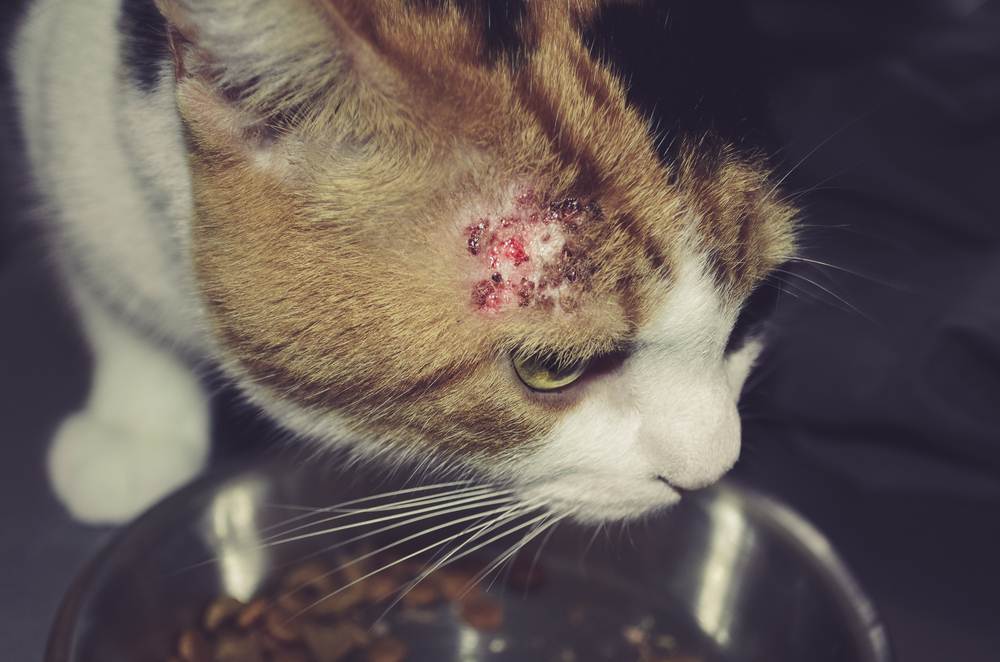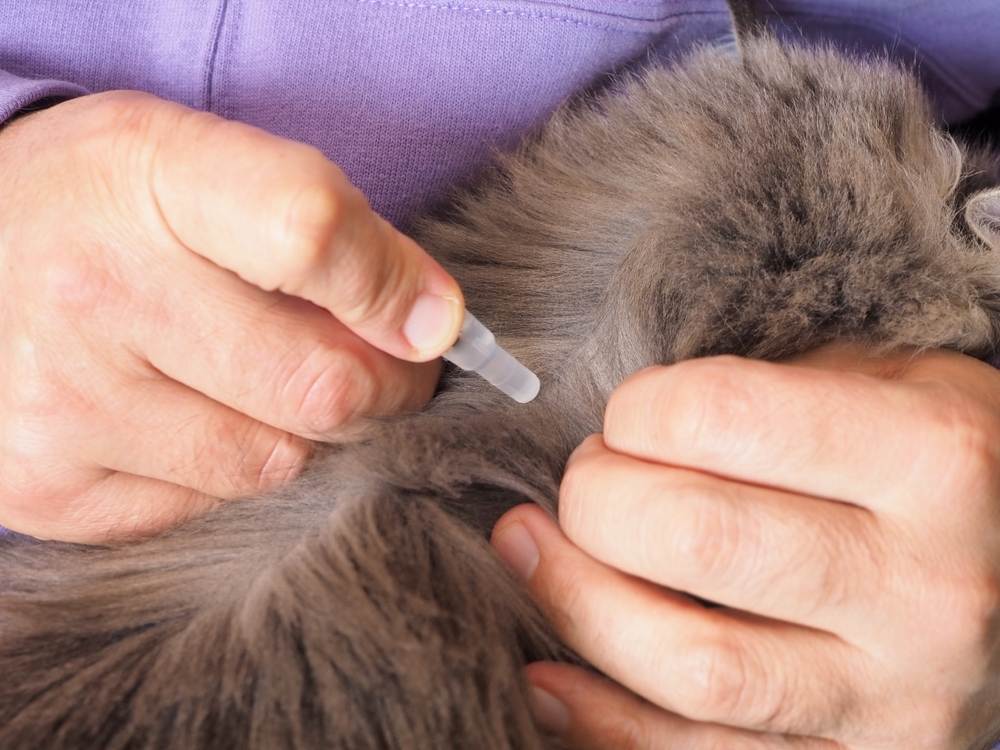
newsony / Shutterstock.com
Flea allergy dermatitis (FAD) is an allergic response to flea bites that causes some cats to have more severe skin problems than are usually seen with fleas. It occurs when a cat is allergic to specific allergens in flea saliva.
For most cats, the presence of even multiple fleas will still lead to only mild itching and scratching. In cats with FAD, however, the immune system identifies allergens in flea saliva as foreign and dangerous to the body, leading to a more severe skin reaction.
Read on to learn what flea allergy dermatitis is, how to recognize it, common treatment options, and how to best prevent it.
Causes of Flea Allergy Dermatitis

An allergic response to a flea’s saliva is always the cause of flea allergy dermatitis. KanphotoSS / Shutterstock.com
There is only one cause of flea allergy dermatitis: an allergic response to a flea bite.
The severity of flea allergy dermatitis does not depend on the number of fleas present. In theory, a single flea bite could cause symptoms in cats with a significant allergy. In fact, it is very common for just a few fleas to be present in cats when they arrive at the vet for an exam. The severity instead depends solely on an individual cat’s immune system and how pronounced its reaction is.
Symptoms of Flea Allergy Dermatitis
There are three categories of symptoms that may be seen with flea allergy dermatitis.
Presence of Fleas
In some cases of FAD, live fleas may be seen on the cat’s skin. Fleas are small but are visible to the naked eye.
However, not being able to spot any of these creatures doesn’t rule out flea-allergic dermatitis. When I see these patients, I have found it is actually common to see few or no fleas at all. This is because a cat with FAD is often more proactive in eliminating visible fleas through grooming behavior because the bites are so much more irritating. However, a single stray flea may also induce FAD.
If no live fleas are seen, there may still be evidence of their presence through flea dirt. This is the term for the feces that fleas leave behind on the skin. After feeding or taking a blood meal from a cat’s skin, fleas will defecate tiny specks of dark black material. Flea dirt may be down near the skin at the base of the fur and hidden from view by fluffy fur coats.
Skin Appearance
There are certain dermatological signs you may see in a cat with FAD:
- Papules and crusts: One of the hallmarks of flea allergy dermatitis is the presence of small raised red bumps, or papules, that are often a little crusty in appearance. These are usually found around the head and neck as well as near the base of the tail. These bumps are not the actual bites themselves but the way the allergy manifests on the skin.
- Excoriations/Rashes: Red, raw, ulcerated areas may be present, especially in cats that have been scratching a lot. Cats’ sharp nails can cause significant trauma to their own skin, leading to inflammation and reddened patches of skin.
- Hair loss: Affected cats may groom and scratch to the point of losing hair over problem areas.
Behavior
The itching and scratching caused by the sensitivity to flea bites and the resulting inflammation can lead to behavioral changes. Cats may act erratically when bitten, racing off through the home and then licking or chewing excessively. Some cats overgroom (groom or chew at themselves more often or for longer spells) and can appear restless and unable to settle.
Diagnosis of Flea Allergy Dermatitis

Hair loss, rash, or raised crusty bumps on the head, neck, or base of the tail are a common pattern with flea allergy dermatitis. Miroslav Pesek / Shutterstock.com
A veterinarian’s diagnosis of FAD is based on three things, alone or in combination.
Live Fleas
Your vet may use a flea comb that has narrow bristles to look for fleas and flea dirt. In many cases, very few fleas – or even none at all – are present. However, the absence of fleas during an exam does not rule out FAD. In this case, your vet may rely on the presence of characteristic skin lesions and/or allergen testing.
Skin Lesions
The appearance of crusty red papules on the head, neck, and top of the back near the tail may highly suggest FAD as a cause to a veterinarian.
I know from personal experience that it may certainly be difficult for a vet to have the discussion with a cat parent that fleas are the likely cause if this is the only sign. This is understandable, but it’s important to remember that cats can still have FAD even if they are indoor only, if fleas have never been seen in the home, and even if fleas aren’t present on the cat during an exam.
Flea Allergy Testing
There are two ways for flea allergy testing to be performed.
The first is intradermal skin testing. A small amount of flea saliva allergen is injected under the skin. The size of the localized skin swelling (called a wheal) that results is compared to a negative control. If the size of the flea saliva allergen site is 3-5mm larger than the control, this supports FAD. This testing method is most often provided by veterinary dermatologists.
The second method is with blood, or serological testing, which can be offered by general practices like my own. In this method, blood serum is evaluated for antibodies, or immunoglobulins, to flea saliva allergens. The presence of immunoglobulin E (IgE) directed against flea saliva antigens may support an FAD diagnosis.
Treatments for Flea Allergy Dermatitis
The basic components of treating flea allergy dermatitis are to kill and eliminate the fleas, and to address the allergic response.
Flea Treatment
If fleas are visibly present, our first focus as vets is to kill the fleas and end the infestation on the cat. This may be with an oral medication like Capstar (nitenpyram) or a topical product like Frontline spray. There are many other products for cats that continue to treat and prevent fleas. Some products kill fleas faster than others, and some address more stages of the flea life cycle than others.
In cats that allow it, bathing may be helpful to remove dead fleas, flea dirt, and to calm irritated skin. Your vet may recommend a particular shampoo. Keep in mind that bathing a cat within 24 hours of application of a topical flea product may decrease effectiveness of the product.
The home environment must also be addressed. Flea eggs and pupae that are present in the home may hatch days or weeks later. At the minimum, all bedding should be washed on a hot water cycle and the home should be thoroughly vacuumed, including between couch cushions and under pillows.
There are home treatment products, like sprays, that can be used to treat hard to reach areas like cracks in floorboards and under furniture. These may not be safe on or near pets when sprayed, so follow directions carefully. Professional treatment may be required in some cases where a flea infestation is extensive.
In many cases, depending on how many fleas are present in the home environment and how many eggs they’ve had an opportunity to lay (up to 50 a day!), it may take anywhere from 1-3 months to fully resolve a flea infestation in the home.
Allergy Medications
Addressing the allergic response may involve steroids and anti-histamine medication. In most cases, over-the-counter antihistamines will not be sufficient on their own and steroid medication will be necessary. The most common steroid medications used are oral prednisolone and the injectable Depo-Medrol (methylprednisolone acetate).
Immunotherapy consists of using small amounts of allergen to desensitize the body and train the immune system to not react to it. This is a common approach to treating pets with a generalized environmental allergy disorder, or atopy. Immunotherapy for flea allergy specifically may be included in immunotherapy, but has varying results [3].
Antibiotics
If a cat scratched themselves, leading to open wounds, secondary bacterial infection is a possibility. Your veterinarian will assess the skin to see if treating for bacterial infection is necessary with an appropriate antibiotic.
Prevention of Flea Allergy Dermatitis

The proper place to apply a flea treatment medication is at the base of the neck just in front of the shoulders. Nick Alias / Shutterstock.com
The only way to prevent flea allergy dermatitis is to prevent any flea bites from occurring.
Regular use of flea prevention for cats is the most reliable way to ensure that fleas are removed from the home environment. If all pets in a home are treated, fleas cannot reproduce and an infestation cannot occur.
I have found it may be very tricky to control this disorder for cats who go outdoors because most products require a flea to come in contact with them. Repelling fleas and rapid-action products are advised, and environmental treatments around the home may help.
Cat Care Tips
- Treat all pets: If you have a cat with FAD, keep all pets in the home rigorously treated with preventative flea medication to keep the home as flea-free as possible
- Treat the environment: Most flea products for cats do not repel fleas. A flea may still be able to bite a treated cat and cause a FAD response in severely sensitive cats. In these cases, it is crucial to eliminate fleas from the environment. Outdoor cats may need to be acclimated to an indoor environment where control is more effective.
- Optimize skin health: Feed your cat a complete diet that’s balanced for their lifestage, and discuss with your vet whether a supplement may help to keep your cat’s skin in top condition.
-
Flea Allergy. (2018, May 21). Cornell University College of Veterinary Medicine.
-
Flea allergy dermatitis in dogs and cats. Boehringer Ingelheim. (2024, February 24). Boehringer Ingelheim.
-
Flea Allergy dermatitis in cats | VCA Animal Hospital | VCA Animal Hospitals. (n.d.). Vca.
-
MacMillan, R., & MacMillan, R. (2023, October 9). Flea Life Cycle explained: How long do fleas live? The Vets.
-
Dryden, M. W. (2021, May 5). Flea allergy dermatitis in dogs and cats. Merck Veterinary Manual.







